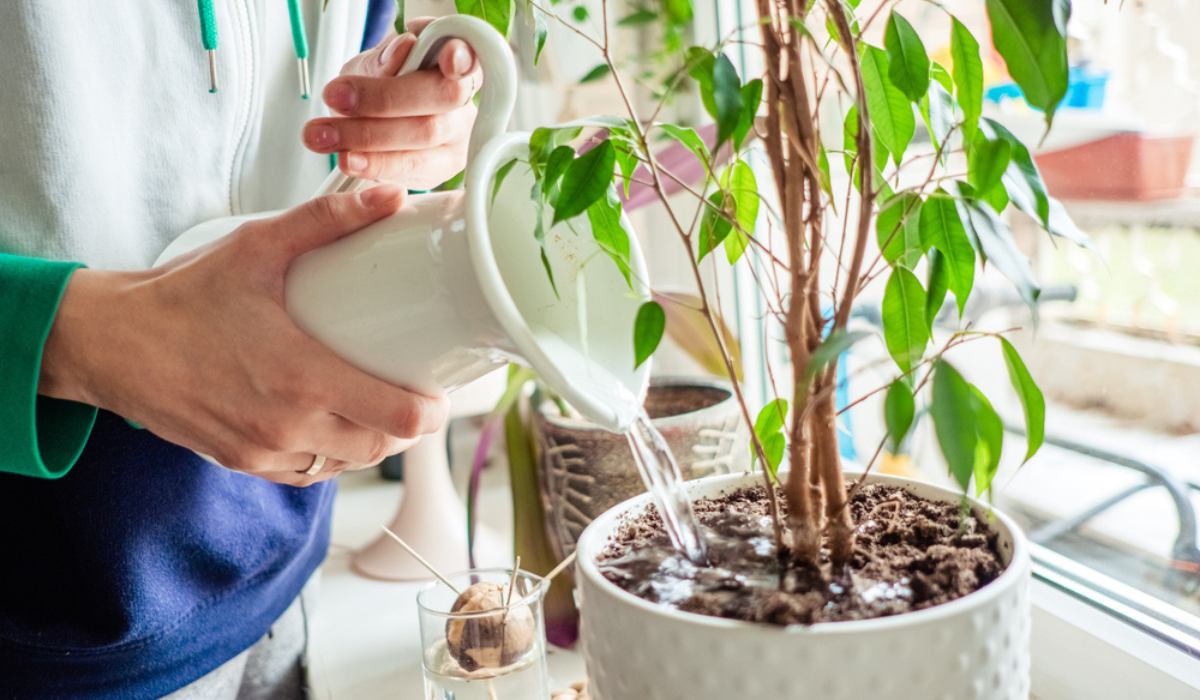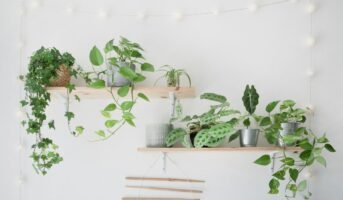Plants require a lot of water in the summer to keep them from wilting. But how frequently and in what amounts should you water? Watering your plant is a given, but determining how much and how often can be challenging. We have a few suggestions for watering plants to ensure survival. Here are some guidelines to assist you in watering your plants effectively for the desired growth.

Source: Pinterest
See also: Nourish your garden with the best fertiliser for plants
What does watering the plants do?
- Water gives your plant structural support, cools down, and transports minerals where needed.
- Plant cells can be compared to water balloons. Your plant holds up and becomes firm when filled with water.
- Lack of water causes the cells to sag and the plant to seem droopy, an obvious warning that your plant needs more water in dry potting soil.
- Water pressure (water flowing through the plant) facilitates plants in gaining and maintaining their shape more effectively than cellulose alone.
- Plants also produce cellulose that helps them maintain their shape.
- Transpiration, an intangible phenomenon, happens when you water your plant. Via the stomatal holes on the leaves, the sun evaporatively removes water, resulting in water loss in the leaf. That’s fantastic since the available water will flow to the areas where it is needed. Although the roots are the preferred water source, if they are dry, water is taken directly from the leaves.

Source: Pinterest
When to water your plants?
It would help if you watered your plants as soon as you notice any wilting leaves, but you don’t want to wait until they reach this stage. They won’t look as beautiful, and it reduces their resistance to diseases. Instead, make it a habit to regularly check on your houseplants to determine whether they need water, preferably once a week. You can also use an app to help remind you when it’s time to make your rounds. Stick your finger into the potting mix for about an inch; get out the watering can if it feels dry. It is the best way to determine whether your plants need water. If you notice any dampness, come back in a day or two to check. You can also take the entire container if the houseplants are smaller. Add water if it seems light for its size. You can feel how heavy the pot should feel when the soil is soaked by lifting it down a second time.
It is best to water your plants in the morning rather than the evening because the extra moisture will have more time to dry and evaporate throughout the day when temperatures are usually warmer. The likelihood of diseases taking hold increases the longer excess moisture remains on plant leaves.
1. Maintain good soil moisture levels
Even moisture is essential for most plants. However, letting the soil get a little bit dry before watering promotes the growth of plant roots.
2. Water less often but thoroughly
It is usually adequate to water the pot plant once to twice per week; it is preferable to water less frequently but with more water than more frequently but with less water.
3. Water late in the evening or early in the morning
Less water evaporates when soil is watered after it has cooled down compared to when it is watered while the soil is still hot. Also, before the heat of the following day, plants can adequately replenish themselves with water.
4. Keep leaves dry to avoid diseases
Wet leaves develop diseases. When leaves are exposed to the sun, they burn slightly (burning glass effect of the water droplets). Keeping plants damp overnight may cause leaf-mould diseases.
5. Ensure the water reaches the roots
When watering properly, the roots must receive enough moisture. Too little water usually only covers the top layer of soil. In addition, adequate watering implies that crop plants are especially reliant on consistently moist soil throughout the period before their harvestable crops are ready.
6. Water plants at the soil level
Your plants’ roots will receive the moisture they require by receiving water when it is directed at their base, where it is most needed. To slowly and thoroughly soak the soil and promote healthy growth, think about wrapping a soaker hose between the plants in a flower or vegetable bed.
7. Water evenly around the plant
Water the plant consistently all around for a balanced, well-developed root system. Constantly watering at just one root point results in one-sided root growth, which affects the soil’s ability to absorb nutrients. As a result, always water the space around the plant and the complete irrigation system.
8. Use water-saving irrigation methods
Water as little as possible and as much as necessary. A moisture sensor-equipped automatic irrigation system installed in the bed, on the balcony, and on the grass simplifies this. To water your plants, use water-saving irrigation techniques like drip irrigation.
9. Avoid waterlogging
Waterlogging prevents roots from breathing air from the soil; the root cells perish without oxygen.
10. Use ideal soil for better water retention
For enhanced water retention, choose high-quality, clay-rich soil. Clay mineral-rich plant soil has better expansion properties. It may store water in the soil better and more evenly. Make sure water drains properly to avoid waterlogging in wet summers and winters.
11. Don’t use broadcast sprinklers to water the plant
Broadcast lawn sprinklers are ineffective and drench the plant’s leaves, which increases the danger of a fungal disease. Much of the water sprayed by this type of sprinkler may evaporate on a hot or windy day before it reaches the plant. Furthermore, plants with damp leaves are more susceptible to disease and mould, another reason sprinklers are not used.
12. Never use a water container with a jet-type spray nozzle
Although pressurised nozzles work well for cleaning driveways and sidewalks, the strong spray they generate can harm delicate plants like flowers and leaves. Moreover, it may disturb the soil near a container plant’s roots. If you don’t have a watering can, simply detach the garden hose’s nozzle, connect it to the hanging pot or container, and let the water trickle out slowly.
13. Check the soil’s moisture level
Dry soil can be detrimental to garden plants. On the other hand, they resent having “wet feet,” which means they suffer if their roots are submerged in water and not receiving enough oxygen. It’s important to quickly examine the soil to ensure you don’t overwater because the soil’s surface may seem dry on a hot, windy day, but the ground beneath may still be wet. Keep a wooden dowel on hand, place it in the garden’s soil, pull it out, and inspect it. If the dowel comes out clean, the soil is dry and needs watering. Moist soil will stick to the dowel.
14. Don’t completely rely on rain
Although they may require more during hot, dry times, most garden plants, flowers, and shrubs thrive when they receive at least 1 inch of water per week. Please don’t rely on rain to keep your plants healthy because there isn’t always enough of it in many areas of the country for them to flourish. Using a rain gauge, you may track your weekly rainfall in the garden. Water your plants more if the gauge shows you receive less than an inch of rain.
Water the plants only when needed. Water automated watering timers are very helpful; just keep an eye on the weather and reduce how often you use them when it’s raining heavily. Both too little and too much moisture can harm plants.
Which water type is ideal for your plants?
How various types of water interact with and impact our bodies vary; the same is true for your plants and various types of water. While some plants can withstand most types of water, many are quite sensitive to the water you use.
First, tap water can seriously harm your plants’ health and ability to grow large or swiftly. While using bottled spring water to irrigate your outdoor plants may not be possible, doing so will benefit your indoor plants greatly. Rainwater and bottled spring water are your ideal options for giving your plants the best care possible. They will suffer from any water that contains sugar or salt!
Distilled water for plants
Distilled water won’t harm your plants, but you’ll notice that they won’t grow as tall or as quickly as those irrigated with rainwater or bottled spring water. Epsom salts have also been recommended to help plants grow more quickly. However, there is no evidence to support this claim. Natural elements in spring water are crucial for your plants’ optimum growth. Your plants will survive in distilled water, but it won’t supply them with any nutrients that will make them thrive.
Added nutrients to the water
For far too long, it has been widely accepted that adding sugar or salt to plant water can hasten their growth and make them larger. Although individuals frequently add substances to their plants’ water in the belief that doing so will benefit them, this is especially popular with roses. Adding these substances to your water will only impede their growth and may even result in rotting. But, adding plant nutrition liquids, sticks, or powders to your purified water can help with growth and general health as intended.
Yet, filtered water will ultimately provide your plant with the ideal experience because it will allow them to simply absorb the moisture they require without additional filtration. It is much simpler for your plant companions to thrive when the water is purified since it enables the plant to absorb the hydration without filtering anything.
Watering plants: Facts
- Most indoor plants prefer warm or tepid water to cold water, which can shock them. Soil absorbs water efficiently when it is warm.
- Tap water can harm some indoor plants. Before using, let the chlorine in the water dissolve overnight.
- Due to the volume of potting soil, plants in larger planters dry out more gradually than those in smaller planters.
- When watering your plant, try to avoid sprinkling water on the leaves because this will cause excess water to slip off directly to the roots, leading to root rot and fungus infections. Most tropical plants have waxy leaves because their natural habitat, the rainforest, can experience extreme rainfall. Waxy leaves reduce the risk of fungus infections and allow water to slide off quickly from the plant. Thus, you don’t need to worry too much about them.
- Unless a succulent plant can withstand drought, expect to water plants more frequently in brighter light and less frequently in lower light.
- If you’re worried about overwatering, start by looking for telltale indications of dehydration, such as wrinkled leaves for succulent plants or drooping stems for tropical plants when combined with dry potting soil.
FAQs
How often should I water my plant?
Even on warm summer days, a good soak every three or four days is best for plants because it forces their roots deeper into the soil, where they are healthier and cooler.
What are the three proper ways of watering plants?
There are three commonly used methods: surface, sprinkler, and drip irrigation.
| Got any questions or point of view on our article? We would love to hear from you. Write to our Editor-in-Chief Jhumur Ghosh at [email protected] |
Housing News Desk is the news desk of leading online real estate portal, Housing.com. Housing News Desk focuses on a variety of topics such as real estate laws, taxes, current news, property trends, home loans, rentals, décor, green homes, home improvement, etc. The main objective of the news desk, is to cover the real estate sector from the perspective of providing information that is useful to the end-user.
Facebook: https://www.facebook.com/housing.com/
Twitter: https://twitter.com/Housing
Email: [email protected]











